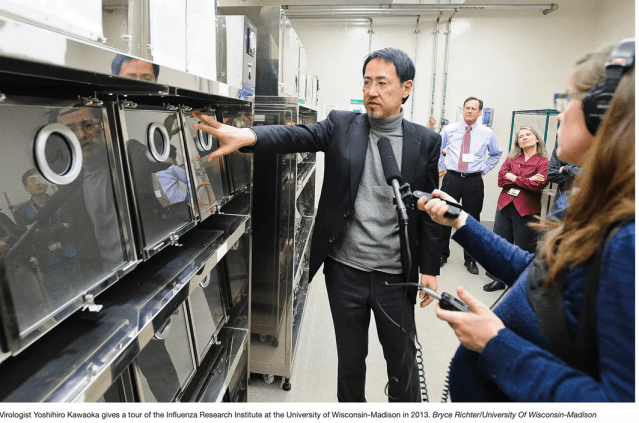Bird flu does not transmit to humans; if it does it will be because it has been engineered in a lab
The Bird flu virus has been modified in laboratories in the USA using gain-of-function to make it infectious and transmissible among mammals.
This research has been occurring for at least a decade. During that time there have been laboratory accidents, one of which is known to have happened at the end of 2019.
It is these laboratory accidents that pose a risk of infection to humans and mammals, not the naturally occurring bird flu.
On 25 March 2024, the World Health Organisation (“WHO”) was notified about a case of human infection with an influenza A (H5N1), bird flu, virus by the national authorities of Vietnam.
According to the International Health Regulations (IHR) 2005, a human infection caused by a novel influenza A virus subtype is an event that has the potential for high public health impact and must be notified to the WHO. WHO will then assess the risk posed to the general population based on available information. In the case of the Vietnamese, WHO assessed the risk of this virus as low.
On 1 April, a person in Texas tested positive for H5N1 bird flu. The Texan worked with dairy cows “presumably infected with H5N1 bird flu viruses,” the US Centres for Disease Control and Prevention (“CDC”) said. This was the second human case of H5N1 bird flu reported in the United States. There was a previous case in 2022 in Colorado in a poultry worker.
The case of the Texan was also reported to WHO. WHO assessed the public health risk to the general population posed by this virus to be low and for occupationally exposed persons, the risk of infection is considered low-to-moderate.
Related: Bird flu in 2005 was used to begin the biggest power grab in history – now it’s back
Last week we published an article by Dr. Joseph Mercola who cautioned: “As we move forward, it is important for to keep an eye on the narratives we’re being fed. If bird flu becomes a human epidemic or pandemic, there are plenty of reasons to suspect it’s a weaponised virus, and the “solution” offered will be the same as that for covid-19: ‘Get vaccinated’.” Dr. Mercola also offered some advice on what to do should they release such a virus.
John Leake agrees that any H5N1 epidemic would likely be due to a virus created in a laboratory. “H5N1 does NOT efficiently transmit to humans and therefore poses little risk to humans,” he notes. “Far more dangerous … is the possibility of a lab-modified H5N1 virus escaping from a laboratory.”
Let’s not lose touch…Your Government and Big Tech are actively trying to censor the information reported by The Exposé to serve their own needs. Subscribe now to make sure you receive the latest uncensored news in your inbox…
A History of H5N1 Laboratory Accidents
By John Leake
Exactly one year ago, the investigative journalist and author, Alison Young, published a report in USA Today on an accident that occurred on 9 December 2019 at the University of Wisconsin’s Influenza Research Institute.
The accident involved experiments with an H5N1 influenza virus that had been modified through gain-of-function (“GoF”) to make it transmissible among ferrets. The research team leader – a renowned virologist named Yoshihiro Kawaoka – had gained international attention (or notoriety) for his controversial GoF research on H5N1. As Alison Young reported:
… in late 2011 the world learned that two scientific teams – one in Wisconsin, led by virologist Yoshihiro Kawaoka, and another in the Netherlands, led by virologist Ron Fouchier – had potentially pushed the virus in that direction. Each of these labs had created H5N1 viruses that had gained the ability to spread through the air between ferrets, the animal model used to study how flu viruses might behave in humans.
The ultimate goal of this work was to help protect the world from future pandemics, and the research was supported with words and funding by two of the most prominent scientists in the United States: Dr. Francis S. Collins, director of the National Institutes of Health (“NIH”), and Dr. Anthony Fauci, director of the NIH’s National Institute of Allergy and Infectious Diseases.
Kawaoka contended it would be “irresponsible not to study” how the virus might evolve in nature. “Some people have argued that the risks of such studies – misuse and accidental release, for example – outweigh the benefits. I counter that H5N1 viruses circulating in nature already pose a threat,” he said at the time.
In November 2013, a needlestick accident happened on Kawaoka’s research team, followed by failure to adhere to the established quarantine rules. Though no human infection resulted from this accident, it was nevertheless alarming. Young’s report continues:
By 2014, there was a growing discomfort at the highest levels of the US government about the risk of an accident with an engineered virus.
Wisconsin’s needlestick incident, which drew questions within NIH but wasn’t publicly known, was soon followed by a series of high-profile accidents at federal labs in 2014 – from safety breaches with anthrax and avian influenza at the CDC to the discovery of forgotten vials of smallpox that had been kept for decades in a storage room on the NIH campus.
In October 2014, citing these federal laboratory incidents, the White House Office of Science and Technology Policy announced a moratorium on new federal funding for certain gain-of-function research while the risks and benefits of the controversial experiments were studied.
The funding pause remained in place for three years until it was finally lifted in December 2017. But it was only in 2019 that some of the halted experiments were quietly allowed to begin again under a revised federal oversight process, which was criticised for keeping secret the details of the new experiments and the basis for the government approvals.
The second accident on Kawaoka’s team occurred less than a year after GoF experiments were allowed to resume. This time, a laboratory researcher in training was working with ferrets infected with the GoF-modified H5N1 when his respirator hose was discovered to have detached from his hood, allowing him to breathe the possibly contaminated air in the cabinet. Again, the quarantine rules were not properly followed, and nor was the incident promptly reported to the NIH.

Though the accident purportedly did not result in a human infection, it nevertheless raises many questions about the prudence of manipulating the H5N1 virus in a laboratory in order to make it infectious and transmissible among mammals.
Alison Young’s report prompted me to start reading her book, ‘Pandora’s Gamble: Lab Leaks, Pandemics, and a World at Risk’, published on 25 April 2023. Young has a long history of researching and reporting on biolabs and their checkered past. Most laboratory manipulation of pathogens is purportedly done to develop vaccines against them in the event that their natural iterations should ever evolve to infect humans, but this rationale is highly questionable if not downright mendacious.
Indeed, on 18 December 2013, the Foundation for Vaccine Research wrote a letter to the European Commission, signed by 56 scientists (including Nobel Laureates) in which they sharply criticised the GoF experiments on H5N1 by virologist, Ron Fouchier.
The 56 scientists vehemently express their opinion that naturally occurring H5N1 does NOT efficiently transmit to humans and therefore poses little risk to humans.
Far more dangerous, they claim, is the possibility of a lab-modified H5N1 virus escaping from a laboratory. The scientists refer to the resurgence of H1N1 influenza in 1977 after a 20-year hiatus, most likely after escaping from a laboratory in the former Soviet Union.
About the Author
John Leake is a true crime author and investigative journalist. Among the books he has written is ‘The Courage to Face Covid-19: Preventing Hospitalisation and Death While Battling the Biopharmaceutical Complex’ which he co-authored with Dr. Peter McCullough. Leake often publishes articles on Dr. McCullough’s Substack page titled ‘Courageous Discourse’ which you can subscribe to and follow HERE.
Featured image: A person in Texas caught bird flu after mixing with dairy cattle. Should we be worried? The Conversation, 8 April 2024

This article has been archived for your research. The original version from The Exposé can be found here.



